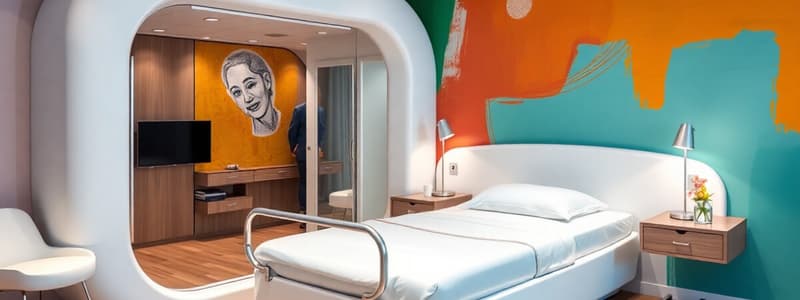Podcast
Questions and Answers
What is a primary reason for including side entrances in bed designs?
What is a primary reason for including side entrances in bed designs?
- To allow for more mattress options
- To accommodate users with mobility limitations (correct)
- To reduce manufacturing costs
- To increase aesthetic appeal
What aspect should be considered first when designing bed entrances for accessibility?
What aspect should be considered first when designing bed entrances for accessibility?
- The color of the bed frame
- The overall design style of the room
- The materials used in other furniture
- The width of the opening (correct)
How does ergonomics impact bed entrance design?
How does ergonomics impact bed entrance design?
- By determining how the bed is visually appealing
- By influencing the color choices for the bed
- By recommending specific materials for aesthetics
- By ensuring comfortable and efficient transfers into and out of the bed (correct)
What is a significant safety consideration in bed entrance design?
What is a significant safety consideration in bed entrance design?
Which material is commonly used for constructing bed frames?
Which material is commonly used for constructing bed frames?
Why is the measurement of entrance height important?
Why is the measurement of entrance height important?
What should the entrance design consider about patient comfort?
What should the entrance design consider about patient comfort?
What can be a feature of hospital beds regarding entrances?
What can be a feature of hospital beds regarding entrances?
Flashcards
Standard Bed Entrance
Standard Bed Entrance
A bed entrance located at the head of the bed, providing easy access and egress.
Side Bed Entrance
Side Bed Entrance
A bed entrance located on one of the bed's sides, beneficial for people with mobility issues or those needing assistance.
Accessibility in Bed Entrance Design
Accessibility in Bed Entrance Design
The design of a bed entrance should accommodate the user's needs, especially individuals with mobility challenges, ensuring safe and comfortable entry and exit.
Safety in Bed Entrance Design
Safety in Bed Entrance Design
Signup and view all the flashcards
Ergonomics in Bed Entrance Design
Ergonomics in Bed Entrance Design
Signup and view all the flashcards
Aesthetics in Bed Entrance Design
Aesthetics in Bed Entrance Design
Signup and view all the flashcards
Patient Comfort in Bed Entrance Design
Patient Comfort in Bed Entrance Design
Signup and view all the flashcards
Materials and Construction in Bed Entrance Design
Materials and Construction in Bed Entrance Design
Signup and view all the flashcards
Study Notes
Types of Bed Entrances
- Standard bed entrances are typically located at the head of the bed, allowing for easy access and egress.
- Some beds have side entrances, which can be useful for individuals with mobility limitations or those needing assistance.
- Alternative bed designs might incorporate a hinged, removable panel or a fold-out section that facilitates access and egress to the bed.
Considerations for Bed Entrance Design
- Accessibility: Entrance design should consider the needs of individuals with limited mobility or those requiring assistance. Considerations include the width of the opening, clearance for wheelchairs or walkers, and any potential obstacles.
- Safety: The design should ensure safe access and egress for the user, minimizing the risk of falls or injury. This can include proper handrails, placement of the entrance, and stability of the bed itself.
- Ergonomics: The entrance should be positioned and sized to allow for a comfortable and efficient transfer or movement into and out of the bed; minimizing strain to caregivers or the bed occupant.
- Aesthetics: Entrance design should be in consideration of the overall aesthetics and functionality of the room. Consideration of materials, colors, and layout will affect the final appearance.
- Patient comfort: The entrance placement and design should support comfortable movement and transfers for all. Consider factors like the direction of the bed to the room's layout and the placement of furniture.
Materials and Construction
- Bed frames are often constructed from various materials, ranging from wood to metal. The selected material should be strong enough to support the patient's weight and allow for the specified entrance design.
- The materials used for the entrance itself, (e.g., handrails, panels) need to be durable and safe, appropriate for the intended use.
- Consider the longevity of materials, ease of cleaning, and potential for future modifications.
Dimensions and Measurements
- Entrance width measurements need thorough consideration, accommodating necessary clearances for the specific individuals or conditions.
- Height measurements are crucial for the entrance to be ergonomic and safe for those using it.
- Depth measurements should take into account the design of the surrounding space and potential obstacles.
Specific Examples and Variations
- Hospital beds and medical beds often have a wider entrance or a unique frame design for easy accessibility.
- Specialized, adaptive equipment like wheelchair ramps may be incorporated in the layout for safe transfers.
- Low-profile beds may require a unique design to facilitate entrance which is specific to the bed's structure or function.
Studying That Suits You
Use AI to generate personalized quizzes and flashcards to suit your learning preferences.



